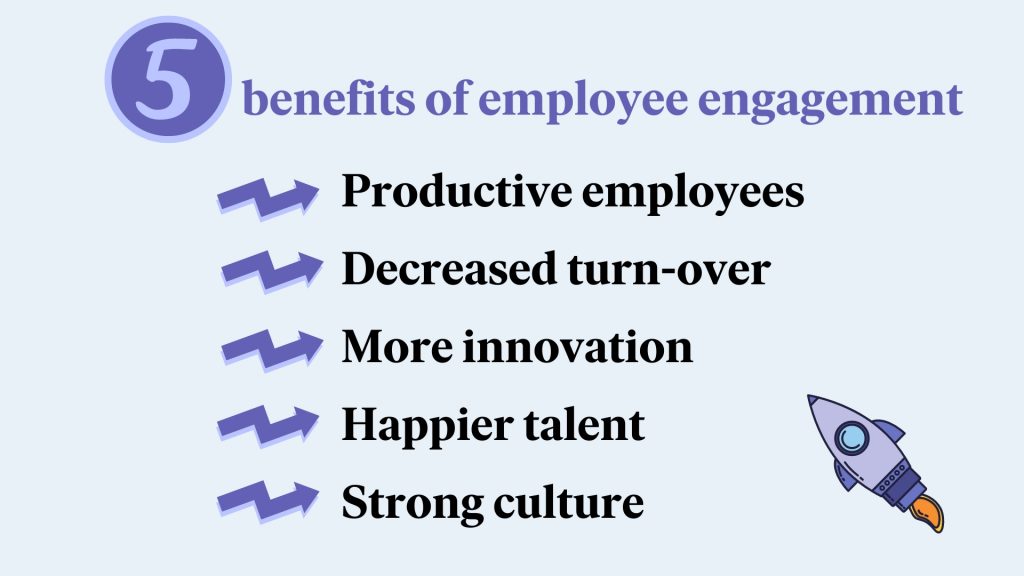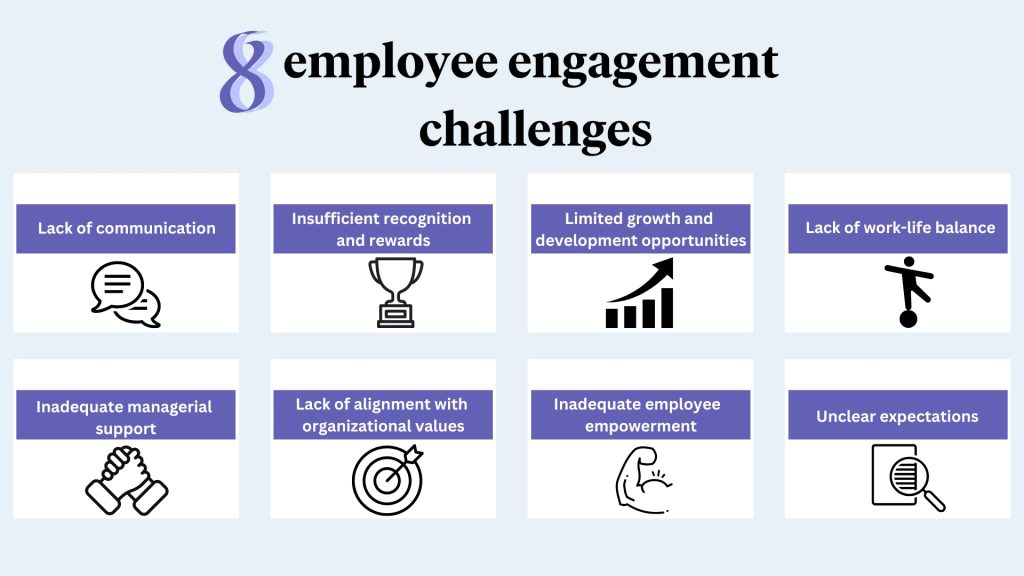The level of employee engagement in your workforce greatly influences how successful your company will be.
Gallup’s Q12 meta-analysis of business units in 96 countries found a strong link between engagement and performance outcomes such as employee retention, productivity, and profitability.
Since the onset of Covid-19, employee engagement has been negatively impacted across the board. According to Gallup’s State of the Global Workplace: 2022 Report, only 21% of employees are engaged at work, and only 33% of employees are thriving in their work environment.
In the same report, Gallup estimates that low levels of employee engagement cost the global economy US$7.8 billion each year.
It’s safe to say employee engagement is an important initiative for business leaders, managers, and employees alike. Which is why People teams are focused on investing in driving employee engagement for their organizations.
What Is Employee Engagement?
Simply put, employee engagement describes the emotional and psychological commitment an employee has towards their work, organization, and its goals. It refers to the level of dedication, enthusiasm, and involvement an employee has in their job, and the extent to which they feel connected to their organization.
Engaged employees are passionate about their work, motivated to go above and beyond their regular duties, and have a strong sense of loyalty towards their employer. They are fully absorbed in their tasks, exhibit a positive attitude, and are willing to contribute their best efforts to help the organization succeed.
Employee engagement creates a virtuous cycle within an organization. Engaged employees contribute to increased productivity, customer satisfaction, and innovation, leading to business success. In turn, a successful and thriving business can invest in employee development, recognition, and well-being, further fostering employee engagement.
Why is Employee Engagement Important?
There are many benefits to employee engagement that lend themselves to the growth of your organization.

Increases productivity
Engaged employees are more focused, motivated, and committed to their work. They go above and beyond their regular duties, leading to higher productivity levels. Engaged employees are also more likely to actively seek out ways to improve processes and contribute innovative ideas, further enhancing productivity. According to Gallup’s report on employee engagement, companies with a highly engaged workforce enjoy 21% greater profitability over their counterparts with less-engaged employees.
Enhances employee retention
A Joblist survey revealed that 73% of employees would consider leaving their jobs if they get the right offer, whether they’re actively looking or not. Engaged employees are more likely to stay with an organization for a longer period. They feel a sense of loyalty and connection to the organization, reducing turnover rates. High employee turnover can be costly and disruptive to business operations, while retaining engaged employees allows for continuity, knowledge retention, and reduced recruitment and training costs.
Accelerates innovation and creativity
Engaged employees are more likely to contribute innovative ideas and solutions to business challenges. They are actively involved in their work, think creatively, and are willing to take calculated risks. Engaged employees feel psychologically safe to share their ideas, fostering a culture of innovation within the organization. All in all, companies with engaged workforces outperform competitors with less-engaged workforces by up to a whopping 202%.
Boosts employee morale
Engaged employees generally have higher job satisfaction and morale. They feel valued, recognized, and supported by their organization, which boosts their overall well-being and job satisfaction. High morale contributes to a positive work environment, fosters teamwork and collaboration, and reduces conflicts and negativity.
Builds a positive organizational culture
Employee engagement plays a crucial role in shaping your organizational culture. When employees are engaged, they contribute to a positive and supportive work culture where teamwork, collaboration, and open communication thrive. A positive culture attracts and retains top talent, improves the employer brand, and creates a cohesive and harmonious work environment.
8 Common Challenges of Employee Engagement
While employee engagement is highly beneficial, organizations often face certain challenges in fostering and maintaining high levels of engagement.

Lack of communication
Inadequate communication from leadership can hinder employee engagement. This can be particularly challenging for companies that have a digital workforce, as remote communication requires its own set of strategies to effectively engage employees. When employees are not kept informed about important updates, changes, or organizational goals, they may feel disconnected and less engaged. Clear and regular communication is essential to engage employees and keep them aligned with the organization’s vision and objectives.
Insufficient recognition and rewards
Employees who feel under-appreciated or undervalued are more likely to become disengaged. If efforts and achievements go unnoticed or unrewarded, employees may feel demotivated and disengaged. Organizations should implement effective recognition and reward systems to acknowledge and appreciate employees’ contributions.
Limited growth and development opportunities
Employees seek opportunities for growth and advancement in their careers. When organizations fail to provide avenues for professional development or promotion, employees may become stagnant and disengaged. Offering training programs, mentorship opportunities, and clear career pathways can help keep employees engaged and motivated.
Lack of work-life balance
Maintaining a healthy work-life balance is crucial for employee well-being and engagement. Organizations that do not prioritize work-life balance may experience higher levels of stress and burnout among employees. Providing flexibility, promoting work-life balance initiatives, and encouraging employees to take time off can contribute to higher engagement levels.
Inadequate managerial support
Poor management practices can negatively impact employee engagement. Managers who lack the necessary skills to effectively lead and support their teams may create an environment of low morale and disengagement. It is important for organizations to invest in training and development for managers to equip them with the skills to effectively engage and motivate their employees.
Lack of alignment with organizational values
When employees’ personal values do not align with the organization’s values, it can lead to a sense of disconnection and decreased engagement. Organizations should clearly communicate their values and ensure that they are reflected in the work environment, policies, and decision-making processes to foster alignment and engagement.
Inadequate employee involvement and empowerment
Employees who feel their voices are not heard or have limited autonomy in decision-making may become disengaged. Organizations should encourage employee involvement, seek their input, and empower them to contribute to decision-making processes. Giving employees a sense of ownership and control over their work can significantly enhance engagement levels.
Unclear expectations and role ambiguity
When employees are unsure about their responsibilities, goals, or performance expectations, it can lead to frustration and disengagement. Be sure to provide clear job descriptions, establish performance goals, and offer regular feedback and guidance to ensure employees understand their roles and expectations.
Addressing these challenges requires a proactive approach from organizations, including effective communication, recognition programs, professional development opportunities, supportive management practices, and creating a positive work culture that values employee well-being and engagement.
How to Drive Employee Engagement Within Your Organization
Driving employee engagement within an organization requires a systematic and comprehensive approach. Here are some strategies to foster and enhance employee engagement:
1. Focus on promoting employee engagement from the start
According to Silkroad’s 2017 State of Talent Report, 53% of HR professionals reported an increase in employee engagement simply by improving the onboarding process in their companies.
Onboarding is your first (and best) opportunity to engage your employees. Onboarding is the foundation for an engaged, productive, and positive workplace, and should be thought of as a tool to drive retention as well as positive business outcomes. Invest in developing a comprehensive, successful onboarding process to promote lasting engagement.
2. Promote effective communication
According to Trade Press Services, effective internal communications motivate 85% of employees to become more engaged in the workplace. Establish transparent and open communication channels to promote a feedback loop that gives you an eye into the employee experience. By keeping employees informed about organizational updates, goals, and progress, you create an informed and therefore engaged workforce.
Encourage two-way communication by actively listening to employees’ feedback, ideas, and concerns through regular 1-on-1 meetings, routine performance reviews, and employee surveys.
3. Clearly communicate company goals
It’s essential that you develop and maintain clear lines of communication with your employees — particularly around the overall goals of your organization.
Consider internal communications such as employee newsletters, press releases, event updates and other company news such as milestones and successful projects
More importantly, emphasize how the individual goals and day-to-day work of all your employees contribute to the team and towards the larger goals of the company through goal setting techniques such as KPIs.
When your employees can see that their efforts make a meaningful difference to your company, they’ll be more driven and engaged in their work.
4. Provide growth and development opportunities
An Employee Job Satisfaction and Engagement survey by SHRM found that only 29% of employees are “very satisfied” with the career advancement opportunities that are available to them.
Identifying opportunities for growth and development illustrates an interest in overall employee well-being, and provides opportunities that will encourage employees to stick with your organization for the long haul.
5. Foster a positive work culture
Cultivate a positive and inclusive work environment that values diversity, respect, and collaboration and encourage teamwork to create opportunities for social interactions among employees.
A positive work culture has many facets. In addition to prioritizing strong values, it’s also important to promote a healthy work-life balance as well as recognize both individual and team accomplishments, and ensure that recognition is timely, specific, and genuine. Consider non-monetary rewards such as public praise, opportunities for growth, and increased responsibility.
6. Conduct regular feedback and performance discussions
Companies who implement regular employee feedback report 14.9% lower turnover rates compared to companies in which employees receive no feedback according to a study by Gallup.
Implementing regular performance reviews and discussions to provide feedback, set goals, and identify areas for improvement not only help employees align their goals with their company mission, but also enable managers to identify pain points early on and take course corrective action to improve the employee experience and performance. Create a culture of continuous feedback and support, to ensure that employees feel heard, valued, and supported in their professional growth.
7. Measure and assess engagement
Companies that seek to build and maintain a strong company culture must regularly audit and fine-tune their employee experience. Doing so requires you to regularly assess employee engagement levels through surveys, retention rates, and other mechanisms that indicate employee engagement.
Remember that driving employee engagement is an ongoing effort that requires commitment and involvement from all levels of the organization. By prioritizing employee engagement and implementing these strategies, organizations can create a positive and engaging work environment that fosters employee satisfaction, productivity, and overall business success.
Invest in Your Employee Engagement with Omni
Employee engagement affects every aspect of your organization, from culture to morale, productivity to innovation, investing in your employees is a sure fire way to improve your business functions and drive growth.
Whether you’re revamping your onboarding strategy or further developing your performance review process, creating a streamlined and consistent experience for your employees is paramount to success.
With Omni, HR professionals can leverage automation and expert created templates to build seamless processes to support each stage of the employee lifecycle, and manage each function in one, easy-to-use platform. Omni’s data analysis and smart-reports allow you to derive real-time, actionable insights on your employee experience so you can build an award winning culture of growth, innovation, and engagement.
Talk with our team today to learn more.


